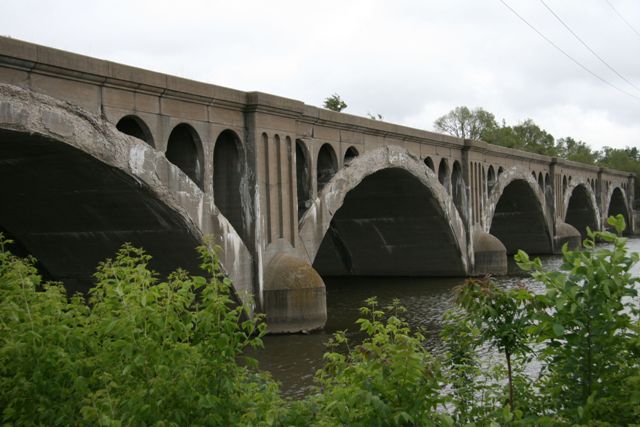We Recommend:
Bach Steel - Experts at historic truss bridge restoration.
BridgeHunter.com Phase 1 is released to the public! - Visit Now
Kankakee Railroad Bridge

Primary Photographer(s): Nathan Holth and Rick McOmber
Bridge Documented: May 8, 2010
Railroad (Illinois Central) Over Kankakee River and River Street
Kankakee: Kankakee County, Illinois: United States
1919 By Builder/Contractor: Gould Construction Company of Davenport, Iowa and Walsh Construction Company of Davenport, Iowa
Not Available or Not Applicable
85.0 Feet (25.9 Meters)
630.0 Feet (192 Meters)
65 Feet (19.81 Meters)
6 Main Span(s)
Not Applicable

View Information About HSR Ratings
Bridge Documentation
This beautiful bridge is an impressive and excellent example of of a reinforced concrete railroad bridge. In general, railroads seem to have preferred metal bridge types for larger bridges and either metal or stone for smaller bridges. In general concrete seems to have been most commonly used with railroad over highway overpasses. There are some exceptions, particularly with specific railroad companies. However, on the whole, concrete arch bridges such as this one are relatively uncommon. They also appears to be particularly rare in the northeastern Illinois region. This adds to the significance of the bridge. As a six span example that appears to retain excellent historic integrity, this is a particularly noteworthy example. An open spandrel design that includes architectural detailing makes this an aesthetically pleasing bridge as well. This bridge was apparently completed 1919 as a four track railroad bridge. Today the bridge only carries a single railroad track, however the bridge does remain active for trains. According to The New international year book, Volume 1923 the bridge replaced a three span metal truss bridge. A construction technique often called "half-width construction" today was used to build this bridge, where half of the new bridge was built, then the previous bridge demolished to make way for the second half of the bridge to be constructed. The article is shown below:
"Kankakee Bridge Of Illinois Central R. R. An interesting project completed during the year was a wide bridge for the Illinois Central Railroad at Kankakee, Ill., built as two bridges without interval by the use of the same equipment twice and two separate set-ups of the same centres. This was a 4-track, 6-arch railway bridge, with five 90-foot and one 60-foot barrel arch spans, with spandrel walls and a deck of precast slabs. It is 64 feet wide, face to face at arch rings, and including the piers the structure required about 16,000 cubic yards of concrete. It took the place of a single-track, three-span steel truss bridge, and construction of the new bridge was undertaken without interfering with the old. After the first half of the bridge was completed, tracks were shifted from the steel bridge to it, the older structure was removed, and the remainder of the new bridge was then built." -The New international year book, Volume 1923
![]()
Photo Galleries and Videos: Kankakee Railroad Bridge
Bridge Photo-Documentation
Original / Full Size PhotosA collection of overview and detail photos. This gallery offers photos in the highest available resolution and file size in a touch-friendly popup viewer.
Alternatively, Browse Without Using Viewer
![]()
Bridge Photo-Documentation
Mobile Optimized PhotosA collection of overview and detail photos. This gallery features data-friendly, fast-loading photos in a touch-friendly popup viewer.
Alternatively, Browse Without Using Viewer
![]()
Maps and Links: Kankakee Railroad Bridge
Coordinates (Latitude, Longitude):
Search For Additional Bridge Listings:
Bridgehunter.com: View listed bridges within 0.5 miles (0.8 kilometers) of this bridge.
Bridgehunter.com: View listed bridges within 10 miles (16 kilometers) of this bridge.
Additional Maps:
Google Streetview (If Available)
GeoHack (Additional Links and Coordinates)
Apple Maps (Via DuckDuckGo Search)
Apple Maps (Apple devices only)
Android: Open Location In Your Map or GPS App
Flickr Gallery (Find Nearby Photos)
Wikimedia Commons (Find Nearby Photos)
Directions Via Sygic For Android
Directions Via Sygic For iOS and Android Dolphin Browser
USGS National Map (United States Only)
Historical USGS Topo Maps (United States Only)
Historic Aerials (United States Only)
CalTopo Maps (United States Only)

